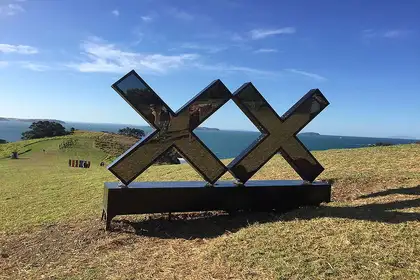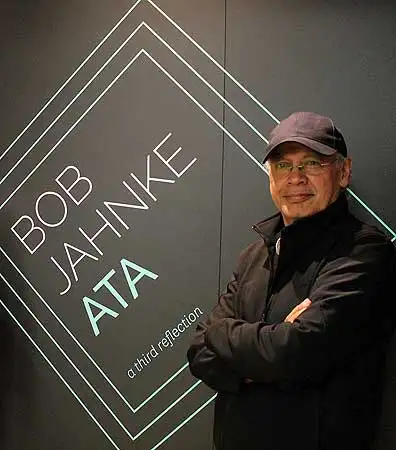
Kaokao as it stood on Waiheke Island in February, both reflecting and at night illuminating light, before its installation at the LUX Light Festival that runs from May 12-21.
With less than two weeks till the opening of the LUX Light Festival, Māori visual artist Bob Jahnke’s installation Kaokao is likely to be among the brightest to shine on the Wellington waterfront.
The 2.4 metre work comprising two x-shaped structures that form a diamond cavity, will soon be a highly visible presence on the waterfront at a precinct of contemporary Māori light works called Te Aō Marama by the Wharewaka Function Centre.
The work is fitted with neon lights, something of a signature artistic accessory for Professor Jahnke, who had a neon exhibition at Porirua’s Pataka Museum and Gallery last year that is now touring North Island centres.
His latest neon installationlit up Waiheke Island earlier this year and is being brought down to Wellington for LUX, the annual celebration of light that this year features more than 30 New Zealand and international works, from May 12-21.
Massey University is a founding partner of the festival.
Professor Jahnke, Ngāi Taharora, Te Whānau a Iritekura, Te Whānau a Rakairoa o Ngāti Porou, founded Massey's pioneering Bachelor of Māori Visual Arts degree more than 20 years ago, and continues to push his own work in new directions – with his neon sculptures a case in point.

Professor Bob Jahnke at the entrance to his neon light exhibition Ata last year at Pataka Gallery.
“The neon is encased in two sheets of glass so it allows light to enter into the sculpture so if you stand up really close to the sculpture you can see through it, “ he says.
“While it’s a single tube of neon what happens to the light is that it reflects to infinity and I kind of like that, for me that infinite layering of the light is what captivates me.
“Unlike other lighting components neons can be formed into patterns, images or text allowing me as an artist to express Māori concepts and forms through the concept of neon.”
Its exposure to the natural elements will also evoke contrasting moods depending on the time of day it is viewed.
“I didn’t expect Kaokao would have all these different facets in terms of interacting with changing light; in bright sunlight the neons are barely visible, when it’s cloudy or raining it becomes a little darker and the illumination of the neon increases in intensity and I like that in terms of what will happen in Wellington.
“It is fortuitous that Kaokao will be close to the Wharewaka because the red light of the neons will appear to emerge as red light out of the darkness. It also allows me to frame the building within the diamond cavity to acknowledge the mana whenua of Ngati Toa and Te Ati Awa.”
Professor Janhke says the installation references a traditional tribal latticework called Kaokao, and through the use of inverted chevrons, Polynesian culture. With the two x shapes the Treaty of Waitangi is referenced too with many of the signatures on that document denoted by crosses.
“I always like to include a little political touch in anything I do,” he says.